Parallel luau
Parallel Luau is a way of achieving real multithreading in roblox using the Actor instance.
What is Multithreading
Multithreading is a way of running multiple tasks at the same time. Base Lua does not have this feature and when you use task.spawn or coroutines it is not really multithreading. The function is still only running on a single thread but Lua makes it so it looks like it is running at the same time
Actors
Actors is an Instance that allows scripts under that Actor to run in Parallel.
Actors and Modules
The Memory under Actors will not be the same so when you require a module a different table will be returned (if your module returns a table) than in the main Thread. This means you can’t use modules to transfer data between Actors.
--Script1
local module = require(...)
module.X = 1
print(module.X) --> 1
--Script2
local module = require(...)
task.wait(1)
print(module.X) --> 1
--Script Under Actor
local module = require(...)
task.wait(1)
print(module.X) --> nil
Communicating Between Threads
There are currently 4 ways to efficiently communicate between threads: Actor Messaging API, Shared Tables, Bindables, or Direct Data Model Communication.
Actor Messaging API
The Actor Messaging API allows a script to receive data from other actors or the main thread. It currently consists of 3 methods: SendMessage(), BindToMessage(), and BindToMessageParallel().
SendMessage
Used to Send Messages between threads. The first argument would be the key while the rest will be the data to send
local Actor = ...
workerActor:SendMessage("myKey", "hello world")
BindToMessage(Parallel)
Used to receive data. If BindToMessageParallel was used then run the code in Parallel. The first Parameter is the key while the second Parameter is a callback.
local Actor = script:GetActor()
Actor:BindToMessage("myKey", function(data)
print(data)
end)
Actor:BindToMessageParallel("myKey", function(data)
print(data)
end)
Shared Tables
Shared Table is like a normal table except its contents are shared between threads. This means that if you update a value in one thread, it will also update for other threads.
local SharedTableRegistry = game:GetService("SharedTableRegistry")
local SharedTable = SharedTableRegistry:GetSharedTable("mySharedTable")
--//Parallel Thread
SharedTable.X = 1
--//Another Parallel Thread
print(SharedTable.X) --> 1
Thread Safety
When using SharedTable you could have race conditions that can cause unwanted behaviors. If you want to know more about race conditions you can check the section below.
Bindables
One of the best ways currently (In my Opinion) to send data between threads is using Bindables as they are almost 4x more efficient than SharedTables.
--//main Thread
local Actor = ...
local BindableFunction = Actor.Bindable
-- assuming you have an event/function parented to the Actor
local data = BindableFunction:Invoke("DoSomething")
--//Actor Script
local Actor = script:GetActor()
local BindableFunction = Actor.Bindable
BindableFunction.OnInvoke(data)
task.desynchronized() -- runs in parallel
return doSomething(data)
end
Sending Data over to actors
When Sending/Returning Tables, avoid large dictionaries if you can. If possible try to convert dictionaries into arrays. Another thing is if your array is going to consist of Strings that are showing up more than once you could send/return two tables, the data table, and a key table or if you can compress your data into a buffer then it is even better.
--//before
local data = {
[1] = "String1",
[2] = "String1",
[3] = "String3",
[4] = "String2",
[5] = "String2",
}
return data
-----------------------------------------
--//after
local key = {
[1] = "String1",
[2] = "String2",
[3] = "String3",
}
local data = {
[1] = 1,
[2] = 1,
[3] = 3,
[4] = 2,
[5] = 2,
}
--to get the value of an index you can do key[valueAtIndex]
return data,key
--or
return {data,key}
This is much more efficient then as it’s faster to Serialize numbers than it is for strings. And the size of the data being sent over is lower as well. (this can also apply to remotes and the actor api)
Direct Data Model Communication
This type of communication uses the Instances under the game and modifying/reading their properties. However, to maintain thread-safety roblox has systems that disallow threads that are desynchronized to read/write to the Instances.
Thread Safety
Thread Safety is the avoidance of race conditions, Which happens when multiple threads try to read and write to a shared resource causing unwanted behaviors. When using Parallel lua with roblox’s DataModel. Roblox already has Thread Safety implemented into its Instances. Roblox has 4 Safety Levels: Unsafe, Read Parallel, Local Safe, and Safe. You can tell if a function/property has one of these tags by looking at the Roblox’s API. If it has no tags then it defaults to UnSafe.
Safety Tags
UnSafe
Functions cannot be called and Properties cannot be read or written (modified) to
Read Parallel
Properties can be read but not written to
Local Safe
If the instance was created was created under an actor then that actor can Read and Write to. Other actors can Read but not write. Functions can be called only in that actor.
Safe
Functions can be called and Properties can be read and written to
Race Conditions
Race Conditions are when a thread reads or writes data when another thread is not finished computing that data, causing data to overlap or create unexpected behaviors.
--Example
local SharedTable = ...
SharedTable.Value = 0
--Let's say we are trying to add to a key called Value in the SharedTable
--Each Thread will add 100 to the Value Key
--//Parallel Thread
for i = 1,100 do
SharedTable.Value = SharedTable.Value + 1
end
--//Another Parallel Thread
for i = 1,100 do
SharedTable.Value = SharedTable.Value + 1
end
--//Outside of Parallel (After Parallel Threads ran)
print(SharedTable.Value)
--> This won't always print 200 as both Parallel are writing to The Value
--at the same time which can overlap
More Explanation
The reason why it’s happening can be shown in this diagram.
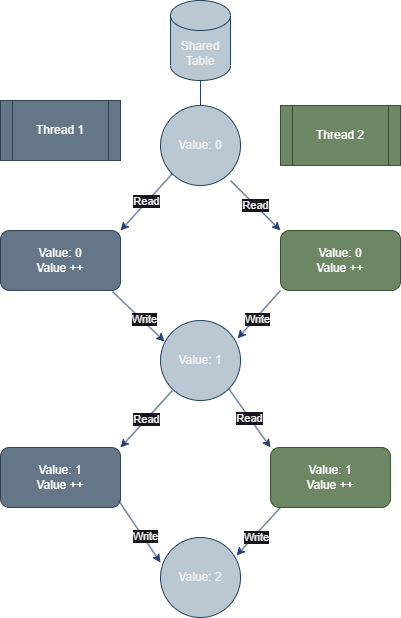
If you look at Value, each time a thread reads and writes it is reading and writing at the same time (this will not always happen). So it means that if both Threads run a for loop increasing Value by 100, the Value will not be 200 most of the time.
Avoiding Race Conditions
When working with the DataModel roblox already implemented Thread Safety as shown above. Otherwise what you can do is combine the data in a Synchronized state so there is a lesser chance of data overlapping with each other or if you are working with a shared table use the functions increment() or update() to update data as it does an atomic update to the values.
Using Microprofiler
To open microprofiler on the client press ctrl-shift-f6. To pause press ctrl-P, If it opens an object viewer press ctrl-shift-f6 twice to reopen it and press ctrl-P again.
Using the Debug Library
You can use profilebegin to help find how long your tasks takes.
local function is_prime(n)
if n <= 1 then
return false
end
for i = 2, math.sqrt(n) do
if n % i == 0 then
return false
end
end
return true
end
local function calculatePrimesFrom(from,to)
debug.profilebegin("primes")
local primes = {}
for i = from,to do
table.insert(primes,is_prime(i))
end
debug.profileend()
return primes
end
calculatePrimesFrom(0,10000)
This will allow you to see how long primes takes to calculate.

which you can see here takes 1.313 ms
How to look for profiles
Profiles will have a unique color depending on the name, so each profile will have the each color each time. To look for a profile look for colored boxes that stand out more.
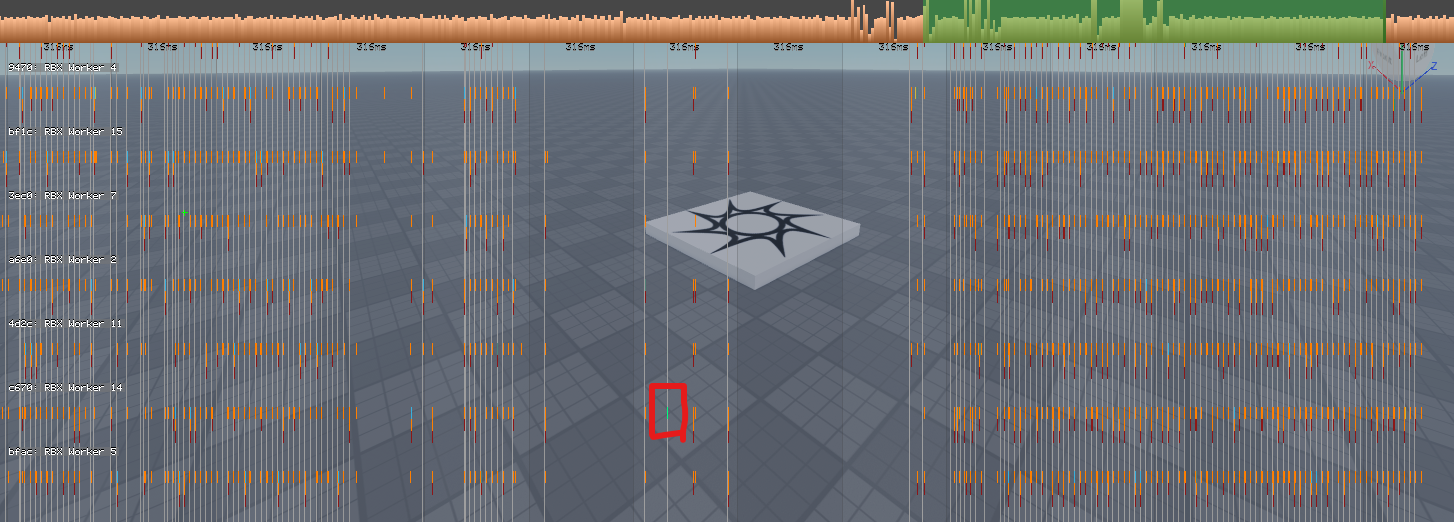
But if your profiles last very short you can sort them by going to Groups and disabling [ALL] and enabling just Script and it will make it easier to spot
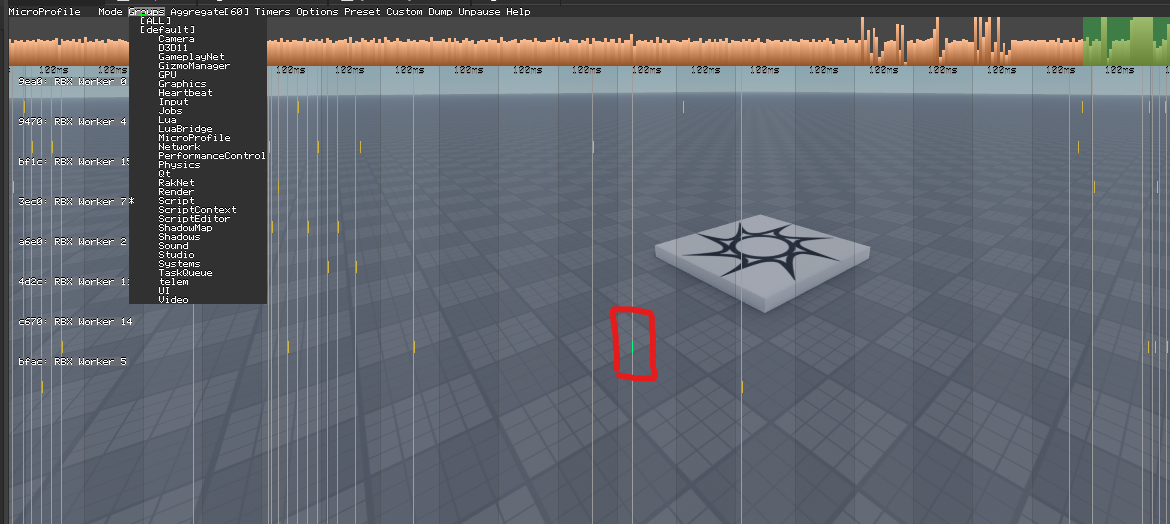
Some other groups I recommend enabling are Lua and TaskQueue. Lua will display the Scripts while TaskQueue will display stuff like the Sleep timer.
Accessing MicroProfiler for Server
To see the microprofiler of a server you would need to go to Developer Console (f9) and go to the MicroProfiler tab.
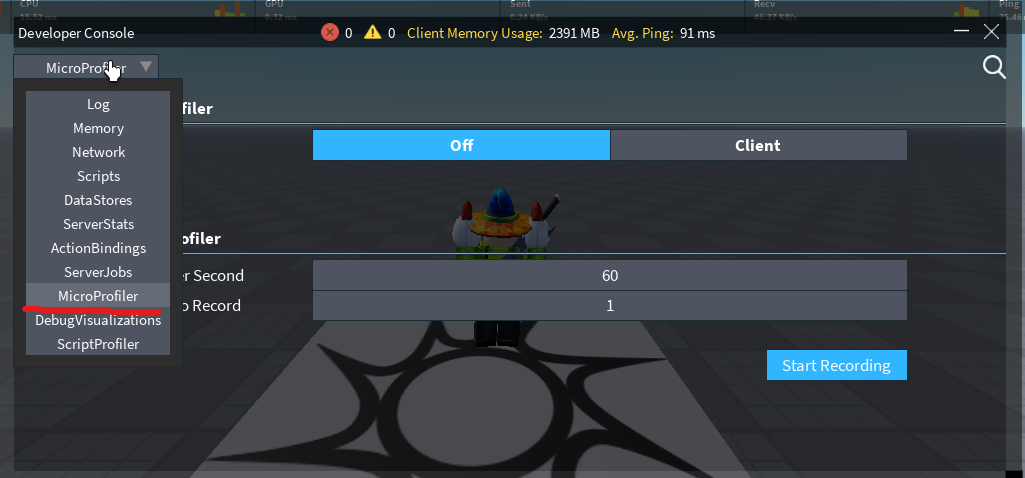
After that, I recommend setting Frames Per Second to 60 and Seconds to Record to 4 (maximum time). And to Record press Start Recording. After it is done Recording it will display a path in which it is saved. Follow that and you can view the data in a browser.
Why multithread
Multithreading can help increase performance by a lot. For example, if we try to calculate the primes from 0-100000 it will take the server

The tasks takes 26.920ms to calculate which is going to cause performance issues as each frame lasts 1/60 seconds which is ~16ms and since the task takes over 16ms the server will lag for 10ms.
But if we split the tasks into 8 separate tasks

each task only takes about 4ms and since they are running in parallel to each other calculating 100000 primes only takes 4ms in total.
Utilizing Parallel Luau properly
When using Parallel Luau it is recommended to separate tasks into smaller tasks. So let’s say you have a task that takes 5ms to compute on a single thread. What you can do is split the tasks into 5 threads, Each chunk taking ~1 ms to compute, Saving 4 ms. Also when using Parallel Luau avoid yielding threads with wait or coroutine. Because when you use task.wait it will bring it out of parallel. And it is also recommended to Avoid long tasks as it will cause the main Thread (not to be confused with the Main script in the Image) to wait for that parallel task to finish. Show below with the Sleep timer.

What we could have done better here was to split the tasks into smaller tasks and use more Actors.
warning Splitting too much
When using Parallel luau try not to split the tasks to into very small sections. If a simple task takes 1 ms on a single thread and you try to split it into 2 separate threads you could see a .4 ms decrease in time but if you split it into 4 threads then you could see it take longer than on a single thread as other factors can cause delay such as going into parallel and sending data across.
How many actors should you use
On a roblox server there is only 2 usable worker threads. While on the client it depends on the client’s device but roblox can only have 8 maxmum workers. Workers are just how many threads can be utilized. Every time you run a parallel task the task will go to one of these workers. Roblox will try to balance which Worker should a task go to.
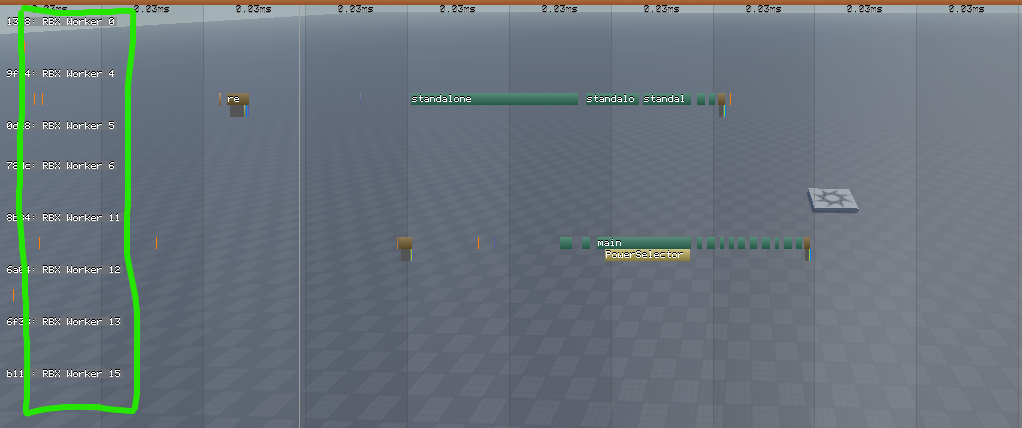
So when determining the number of Actors you want to use it is usually recommended to use more Actors than workers as roblox will balance the tasks between workers.
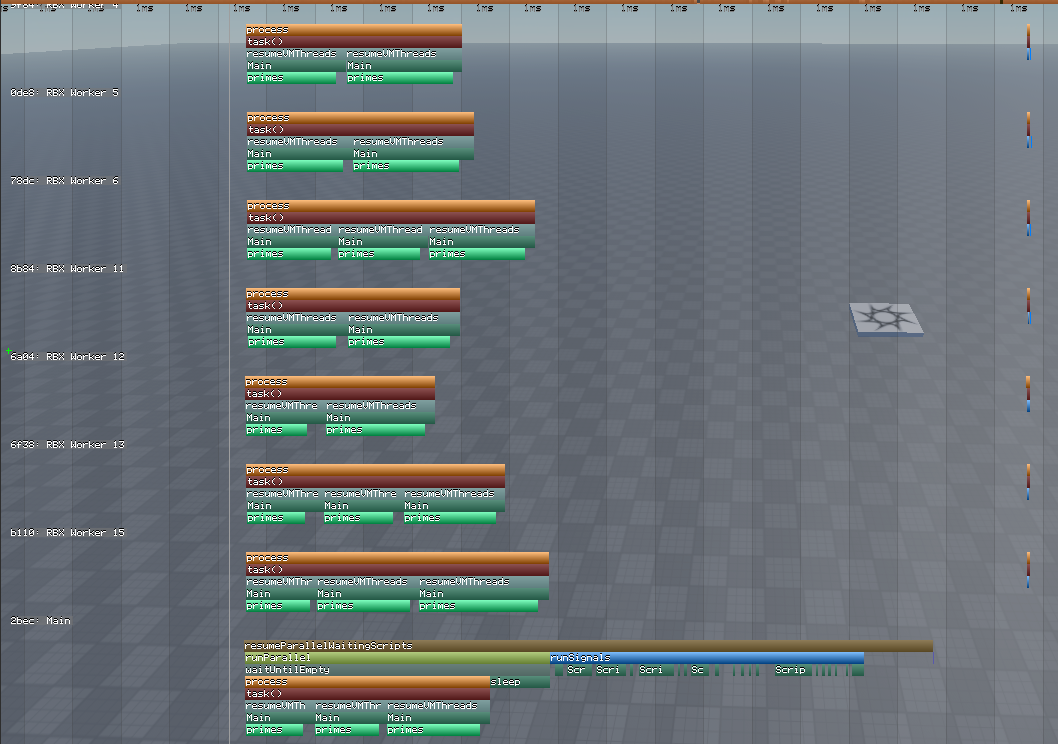
but avoid using too many or else other problems such as memory will show up.
Conclusion
Parallel Luau is not an easy thing to explain and understand so don’t worry if you don’t understand. If you want to see the code I used for the Images above, make a copy of this place. If you want to learn more about Parallel Luau check out here.